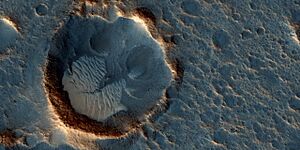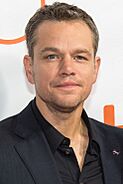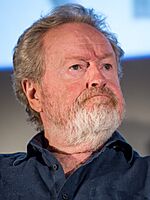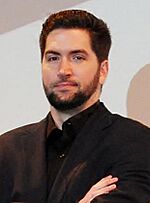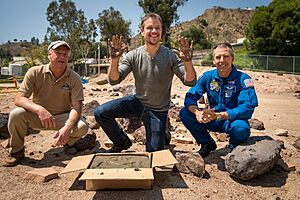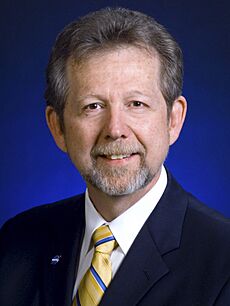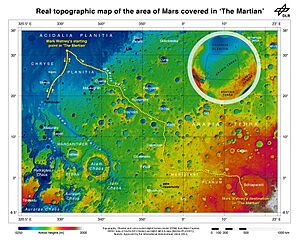The Martian (film) facts for kids
Quick facts for kids The Martian |
|
|---|---|
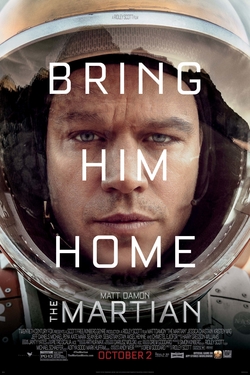
Theatrical release poster
|
|
| Directed by | Ridley Scott |
| Produced by |
|
| Screenplay by | Drew Goddard |
| Starring | |
| Music by | Harry Gregson-Williams |
| Cinematography | Dariusz Wolski |
| Editing by | Pietro Scalia |
| Distributed by | 20th Century Fox |
| Release date(s) | September 11, 2015 (TIFF) September 30, 2015 (United Kingdom) October 2, 2015 (United States) |
| Running time | 142 minutes |
| Country |
|
| Language | English |
| Budget | $108 million |
| Money made | $630.6 million |
The Martian is an exciting science fiction film from 2015, directed by Ridley Scott. It tells the amazing story of an astronaut who gets stranded on Mars and has to use his smarts to survive. The movie is based on a popular 2011 book by Andy Weir. Matt Damon stars as the main character, Mark Watney, with a talented cast including Jessica Chastain, Jeff Daniels, and Kristen Wiig. The film shows NASA's incredible efforts to bring their astronaut home from the Red Planet.
The movie was a huge hit, earning over $630 million worldwide. Critics loved it, and it was even named one of the top ten films of 2015 by important groups like the National Board of Review. It also received many awards and nominations, including seven at the 88th Academy Awards.
Contents
Story of Survival on Mars
The story begins in 2035. A team of astronauts, called the Ares III mission, is exploring Acidalia Planitia on Mars. During their mission, a huge dust storm hits. The crew has to leave quickly in their Mars Ascent Vehicle (MAV). During the rush, astronaut Mark Watney is hit by flying debris and everyone thinks he is dead. The rest of the crew has to leave Mars without him to save themselves.
Mark Watney wakes up after the storm. He is hurt but alive! He is all alone in the crew's surface habitat, called the "Hab." He starts a video diary to record his thoughts and plans for survival. Mark knows he can't talk to Earth. His only hope is the next Mars mission, Ares IV, which will land in four years at the Schiaparelli crater. The Ares IV MAV is already waiting there.
Mark, who is a botanist, knows he needs food and a way to travel. He decides to grow potatoes inside the Hab. He uses Martian soil and the crew's organic waste as fertilizer. He also creates water from leftover rocket fuel. To reach the Ares IV landing site, he modifies a special rover for a long journey.
Back on Earth, a NASA satellite planner named Mindy Park sees something unusual in satellite images. She realizes Mark Watney is alive! NASA director Teddy Sanders shares the news with the public. However, he decides not to tell the Ares III crew yet, who are on their way back to Earth. Flight director Mitch Henderson strongly disagrees with this decision.
Mark explores the area and finds the old Pathfinder probe. He hopes to fix it to talk to Earth. Mars missions director Vincent Kapoor at NASA understands Mark's plan. He works with the Jet Propulsion Laboratory (JPL) to use a replica of the probe. Soon, NASA makes contact with Mark! He can now communicate by text using the Pathfinder and his rover. With this amazing breakthrough, Mitch Henderson finally tells Mark's crewmates that he is alive.
One evening, a leak in the Hab's airlock causes an explosion. Mark is injured, and his potato garden is destroyed. He fixes the airlock, but now he faces starvation again. NASA quickly tries to send a resupply ship. Director Sanders rushes the mission, skipping some safety checks. This causes the ship to break apart shortly after launch.
The China National Space Administration offers to help. They have a powerful rocket that was meant for their own space probe. Astrophysicist Rich Purnell comes up with a daring plan. Instead of sending the Chinese rocket directly to Mark, they could send it to resupply the Hermes (Mark's original crew's ship). The Hermes could then use Earth's gravity to "slingshot" back to Mars much faster. Sanders thinks this plan is too risky for the Ares III crew. But Henderson secretly sends the idea to the crew. They all agree to the risky plan and change course for Mars. Sanders has to support them publicly, but he asks Henderson to resign after the mission.
After several months, Mark begins his long trip to the Ares IV MAV. He plans to use it to meet the Hermes. He has to make the MAV much lighter by removing parts of the cockpit. He launches into orbit. But the Hermes crew realizes they are still too far and moving too fast to catch him. Commander Lewis quickly comes up with an idea. She causes an explosion in part of their ship, using the escaping air to slow them down. Lewis then uses a special jetpack (Manned Maneuvering Unit) to try and reach Mark. They are still too far apart. Mark then bravely pokes a hole in his own space suit. The escaping air pushes him towards Lewis, and he narrowly catches her! NASA and people all over the world celebrate their successful rescue.
After returning to Earth, Mark Watney becomes an instructor, teaching new astronauts how to survive. Five years later, everyone involved in his rescue watches as the Ares V mission launches.
Meet the Characters
- Matt Damon as Dr. Mark Watney, a botanist and engineer on the Ares III team. He is the astronaut stranded on Mars.
- Jessica Chastain as Commander Melissa Lewis, the leader of the Ares III mission. She is an oceanographer and geologist.
- Chiwetel Ejiofor as Vincent Kapoor, NASA's Director of Mars Missions.
- Kristen Wiig as Annie Montrose, the director of media relations for NASA.
- Jeff Daniels as Theodore "Teddy" Sanders, the head of NASA.
- Michael Peña as Major Rick Martinez, the pilot of the Ares III mission.
- Sean Bean as Mitch Henderson, the flight director for the Hermes spacecraft.
- Kate Mara as Beth Johanssen, the Ares III's system operator.
- Sebastian Stan as Dr. Chris Beck, the flight surgeon for the Ares III mission.
- Aksel Hennie as Dr. Alex Vogel, a German navigator and chemist on Ares III.
- Mackenzie Davis as Mindy Park, a satellite planner at Mission Control.
- Benedict Wong as Bruce Ng, the director of Jet Propulsion Laboratory (JPL).
- Donald Glover as Rich Purnell, a smart scientist at JPL who comes up with a rescue plan.
- Chen Shu as Zhu Tao, a scientist from the China National Space Administration.
- Eddy Ko as Guo Ming, the chief scientist at the China National Space Administration.
- Nick Mohammed as Tim Grimes, a JPL engineer who helps with the Pathfinder probe.
The actors worked hard to prepare for their roles. Jessica Chastain met with real astronauts and scientists at NASA's Jet Propulsion Laboratory. She was inspired by astronaut Tracy Caldwell Dyson. Matt Damon spent time with director Ridley Scott, going through the script to understand Mark Watney's journey.
How the Film Was Made
The film The Martian was directed by Ridley Scott. The story came from a screenplay by Drew Goddard, which was based on Andy Weir's 2011 novel.
- Ridley Scott – director, producer
- Simon Kinberg – producer
- Michael Schaefer – producer
- Aditya Sood – producer
- Mark Huffam – producer
- Drew Goddard – screenwriter, executive producer
- Andy Weir – author (source material)
- Dariusz Wolski – cinematographer
- Arthur Max – production designer
- Janty Yates – costume designer
- Pietro Scalia – editor
- Harry Gregson-Williams – music composer
Bringing the Story to Life
20th Century Fox bought the rights to the novel in March 2013. Producer Simon Kinberg started working to turn the book into a movie. Drew Goddard first wrote the screenplay and was going to direct. Matt Damon was interested in starring. However, Ridley Scott later took over as director, and Damon was confirmed as the main actor. Scott was drawn to the film because of its focus on science. Damon liked the book, the script, and the chance to work with Scott. Once Scott joined, the project moved quickly and was approved for production.
Filming Locations and Sets
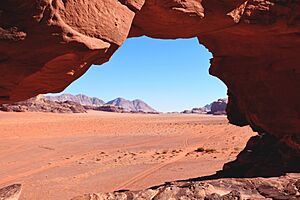
Filming for The Martian began in Hungary on November 24, 2014. They used Korda Studios near Budapest, which has one of the world's largest sound stages. About 20 different sets were built for the movie. They even grew real potatoes on a sound stage next to where they were filming! These potatoes were planted at different times to show them growing in various stages in the movie.
For the outdoor scenes that looked like Mars, the crew went to Wadi Rum in Jordan. This beautiful desert area is a UNESCO world heritage site. They filmed there for eight days in March 2015. Wadi Rum has been used for other Mars movies before. In total, filming lasted about 70 days.
A special Mars rover model was built for the movie. After filming, the cast and crew gave this rover model to Jordan as a thank you. It is now displayed in Jordan's Royal Automobile Museum.
Director Ridley Scott wanted to show Mark Watney's isolation on Mars. He and Matt Damon were inspired by the documentary Touching the Void, about trapped mountain climbers.
NASA's Role in the Movie
When the book was first published, NASA invited author Andy Weir to visit their facilities. When Ridley Scott started making the film, Weir contacted NASA to help. NASA decided to work with the filmmakers. They saw it as a great chance to promote space exploration and show how science and technology work.
NASA staff, including James L. Green, director of the Planetary Science Division, helped the film crew. Scott talked with Green several times. For a whole month, NASA answered hundreds of questions about space systems, future Mars habitats, and more. They also provided many real images of Mars and control centers. This helped the production designer, Arthur Max, create realistic sets.
Newsweek magazine reported that NASA helped The Martian more than most other space movies. NASA even included the front page of the film's script in the payload of the Orion spacecraft during a test flight on December 5, 2014.
The Los Angeles Times said that NASA hoped the film would get people excited about a human mission to Mars. The New York Times noted that the film was a good advertisement for NASA. Jim Erickson, a NASA project manager, said the film showed the "risks and rewards" of traveling to Mars.
In October 2015, NASA launched a new online tool. It allowed people to follow Mark Watney's journey across Mars. It also shared details about NASA's real plans for human missions to Mars.
In 2016, then-U.S. President Barack Obama said The Martian was one of the best science fiction films he had ever seen.
The Film's Music
Harry Gregson-Williams composed the music for The Martian. This was his fourth time working with director Ridley Scott.
A fun part of the movie is Commander Melissa Lewis's love for 1970s disco songs. These are the only songs Mark Watney has on Mars, and he often complains about them! The soundtrack includes popular songs like:
- "Turn the Beat Around" by Vicki Sue Robinson
- "Hot Stuff" by Donna Summer
- "Rock the Boat" by The Hues Corporation
- "Don't Leave Me This Way" by Thelma Houston
- "Starman" by David Bowie
- "Waterloo" by ABBA
- "Love Train" by The O'Jays
- "I Will Survive" by Gloria Gaynor (played during the closing credits)
The songs "Don't Leave Me This Way" and "I Will Survive" are especially fitting for Mark Watney's situation on Mars.
Promoting the Movie
20th Century Fox used creative ways to promote The Martian. On June 7, 2015, NASA astronaut Michael J. Massimino shared a video diary. It showed Matt Damon's character and the other crew members as if it were a real mission video. This was a "viral marketing" campaign.
The studio then released the official trailer on June 8. Forbes magazine said it was a "pretty perfect trailer" because it showed the story, the main character, the famous actors, and ended with a funny tagline. Jimmy Kimmel even made a funny spoof trailer called The Mastronaut: Emission to Mars.
In August 2015, Fox released more videos, including interviews with the main crew members. NASA also hosted a "Martian Day" at the Jet Propulsion Laboratory. This event promoted both The Martian and NASA's real efforts to send humans to Mars.
NASA helped market the film, even though they had not done so for many other space movies. The Martian was even shown on the International Space Station (ISS) on September 19, 2015! It was also screened at NASA centers in Houston and Cape Canaveral.
In November 2015, 20th Century Fox announced The Martian VR Experience. This was a "virtual reality adventure" where viewers could play as Mark Watney. They could re-enact scenes from the film. This project won two major awards.
Film's Success and Release
The Martian premiered at the 2015 Toronto International Film Festival on September 11, 2015. It was released in the United Kingdom on September 30 and in the United States on October 2, 2015. The film was shown in 2D, 3D, IMAX 3D, and 4DX formats.
Box Office Performance
The Martian was a big financial success. It earned $228.4 million in the United States and Canada. It made $402.2 million in other countries. This brought its worldwide total to $630.6 million. The film's budget was $108 million. It became the tenth-highest-grossing film of 2015 worldwide.
In North America, the film opened on October 2, 2015. It earned $54.3 million during its first weekend. This was the second-biggest October opening ever, just behind Gravity. The film stayed at the top of the box office for two weekends. It returned to the top for a third time in its fourth weekend.
Internationally, The Martian was released in 81 countries. It earned $44.6 million in its first international weekend. It opened at number one in over 15 markets. Its biggest earnings came from South Korea, the United Kingdom, Russia, France, Australia, and Germany. The film earned $95 million in China. It also did very well in Japan, where it was released in February 2016.
Watching at Home
The Martian became available for digital download on December 22, 2015. It was released on Blu-ray and DVD on January 12, 2016. A special extended version of the film, with ten extra minutes, was released on June 7, 2016.
Science Behind The Martian
When Andy Weir wrote the novel The Martian, he worked hard to make the science accurate. Director Ridley Scott also wanted the film to be realistic. He got help from James L. Green, a director at NASA's Planetary Science Division. Green put together teams to answer Scott's scientific questions.
Green said that The Martian is "reasonably realistic." However, he noted that the film's dangerous dust storm, even at 120 miles per hour, would actually have a very weak force on Mars. This is because Mars' atmosphere is very thin. Screenwriter Drew Goddard agreed that the winds had to be exaggerated for the story to begin.
The way Mark Watney made water in the film was accurate. NASA is even using similar methods for planned Martian rovers. The radioisotope thermoelectric generator (RTG) used for heat was also correct. Mark's plan to grow potatoes using Martian soil and organic waste was a clever idea. However, scientists have since found that Martian soil might be toxic to plants and animals.
Some parts of the film were changed for the story. For example, Martian gravity is less than 40% of Earth's. But the director chose not to show this difference. He felt the heavy spacesuits would make up for it. Also, Mars is extremely cold, with an average temperature of about -80°F (-60°C). This would make some of Mark's early plans difficult.
The rescue plan in the movie used a technique called gravity assist. This is a real method used by spacecraft to get a speed boost from a planet's gravity. It has been used in many robotic missions.
Ed Finn, a director at Arizona State University, said the story does a great job of imagining a near-future scenario that feels very possible. British physicist Brian Cox called The Martian "the best advert for a career in engineering I've ever seen."
See also
 In Spanish: The Martian para niños
In Spanish: The Martian para niños
- Astrobotany and astrobiology
- Project Hail Mary, another science fiction novel by Andy Weir, which has a film adaptation planned.
- List of films set on Mars
- Martian
- Oxia Palus quadrangle
- Robinsonade
- Survival film


